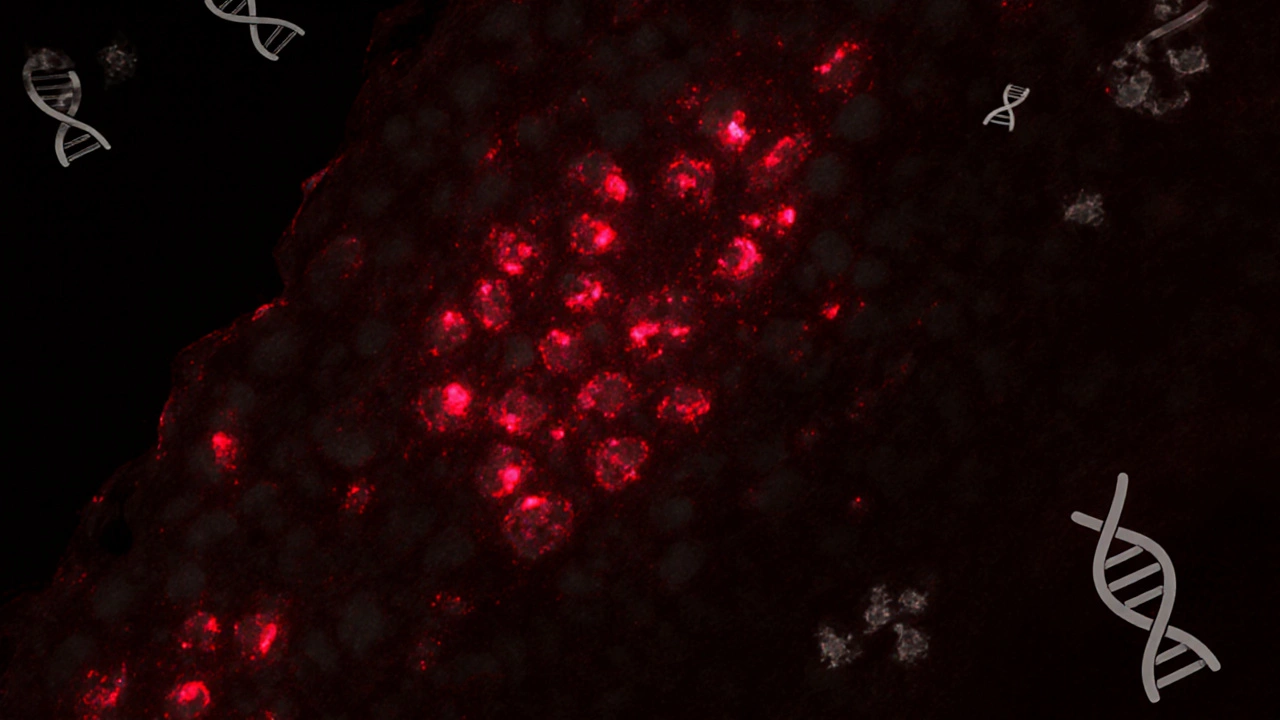Aggressive Cancer Comparison Tool
Compare Aggressive Cancer Types
Select the cancers you want to compare. This tool shows key metrics including survival rates, growth patterns, and typical behavior.
Key Takeaways
- Aggressive cancers grow fast, metastasize early, and have the lowest 5‑year survival rates.
- Pancreatic, small‑cell lung, glioblastoma, acute myeloid leukemia and mesothelioma top the list.
- Median survival for many of these cancers is under a year without treatment.
- Early detection, molecular profiling, and multimodal therapy improve outcomes.
- Patients can use a simple checklist to stay alert to warning signs.
When you hear the phrase Aggressive cancer is a malignancy that grows quickly, spreads early, and often leads to low survival rates, the question “which cancer is the most aggressive cancer?” feels urgent. Aggressiveness isn’t just a medical buzzword; it determines how fast a tumor can outpace the body’s defenses, how soon it spreads to distant organs, and ultimately how many lives it claims. This guide breaks down the science, ranks the deadliest types, and gives you practical steps to stay ahead of the curve.
What Makes a Cancer Aggressive?
First, let’s demystify the term. An Aggressive cancer exhibits rapid cell division, early metastasis, and resistance to standard therapies. Three measurable factors usually decide the ranking:
- Growth rate - how quickly tumor cells double.
- Metastatic potential - the likelihood of spreading beyond the original site.
- Survival statistics - median overall survival and 5‑year survival percentages.
Researchers use Ki‑67 labeling, tumor staging, and genomic instability scores to quantify these traits. The higher the Ki‑67 index, the faster the cells are proliferating. Meanwhile, mutations in TP53, KRAS, or MYC often signal a higher chance of early spread.
Top Aggressive Cancer Types
Below are the cancers that consistently rank at the top for aggressiveness based on worldwide epidemiological data from 2022‑2024.
- Pancreatic cancer has a 5‑year survival of about 10 % and a median survival of 6‑12 months after diagnosis.
- Small‑cell lung cancer (SCLC) accounts for 15 % of lung cancers but kills faster, with a 5‑year survival under 7 %.
- Glioblastoma multiforme the most lethal primary brain tumor, with median survival around 15 months despite aggressive surgery and chemoradiation.
- Acute myeloid leukemia (AML) a blood cancer where median overall survival sits at 12‑18 months without transplant.
- Mesothelioma linked to asbestos exposure, with median survival under 12 months and a 5‑year survival below 5 %.
- Triple‑negative breast cancer (TNBC) lacks hormone receptors, grows fast, and has a 5‑year survival around 77 %-lower than hormone‑positive subtypes.
These cancers share a common pattern: late‑stage detection, high genomic instability, and limited response to conventional therapies.

Side‑by‑Side Comparison
| Cancer Type | Median Survival (months) | 5‑Year Survival % | Typical Growth Pattern |
|---|---|---|---|
| Pancreatic cancer | 6‑12 | 10 | Rapid invasion of surrounding tissue |
| Small‑cell lung cancer | 8‑12 | 6‑7 | Early metastasis to brain, liver, bone |
| Glioblastoma | 15 | 5‑7 | Infiltrative growth across white matter |
| Acute myeloid leukemia | 12‑18 | 25‑30 (age < 60) | Rapid proliferation in bone marrow |
| Mesothelioma | 9‑12 | 4‑5 | Slow but relentless pleural thickening |
| Triple‑negative breast cancer | 24‑36 | 77 | High Ki‑67 index, early nodal spread |
Why Aggressiveness Matters for Patients
Understanding how aggressive a tumor is shapes every decision - from screening frequency to treatment intensity. For instance, a patient with early‑stage pancreatic cancer may be offered a Whipple procedure followed by adjuvant chemotherapy, whereas a similar‑stage SCLC patient might receive chemoradiation plus prophylactic cranial irradiation.
Aggressive cancers also tend to develop resistance mutations faster. That’s why oncologists now run comprehensive genomic panels at diagnosis, looking for targetable alterations like BRCA‑mutated pancreatic cancer (eligible for PARP inhibitors) or ALK rearrangements in rare aggressive lung tumors.
Early Detection Strategies
Because these cancers hide well until they’re advanced, vigilance is key. Here are evidence‑based tactics:
- High‑risk screening: Annual low‑dose CT for heavy smokers over 55 catches SCLC early. For pancreatic cancer, endoscopic ultrasound (EUS) is recommended for those with a family history or hereditary pancreatitis.
- Blood biomarkers: CA‑19‑9 (pancreatic), NSE (SCLC), and circulating tumor DNA panels are increasingly used to flag rapid disease progression.
- Genetic counseling: BRCA, PALB2, and TP53 testing can identify individuals who benefit from enhanced surveillance or preventive surgery.
When symptoms appear-unexplained weight loss, persistent cough, new neurological deficits-don’t wait for a “usual” diagnosis. Prompt imaging and biopsy can shave months off a lethal timeline.

Treatment Options Tailored to Aggressiveness
Modern oncology blends surgery, radiation, chemotherapy, targeted therapy, and immunotherapy. The most aggressive tumors often need a multimodal push:
- Surgery: Removes bulk tumor; works best when disease is still localized (e.g., early pancreatic head tumors).
- Radiation: Stereotactic body radiotherapy (SBRT) delivers high doses in few sessions, useful for brain metastases from glioblastoma.
- Systemic therapy: Platinum‑based doublets for SCLC, FOLFIRINOX for pancreatic cancer, and hypomethylating agents for AML.
- Targeted agents: PARP inhibitors for BRCA‑mutated pancreatic cancer; BRAF‑MEK inhibitors for rare aggressive melanoma subtypes.
- Immunotherapy: Checkpoint inhibitors (nivolumab, pembrolizumab) have modest success in mesothelioma and some glioblastoma trials.
Clinical trials remain a lifeline for many patients with aggressive disease, offering access to novel CAR‑T cells, bispecific antibodies, and next‑generation sequencing‑guided combos.
Quick Checklist for Patients and Caregivers
- Know your family history - ask about early‑onset cancers.
- Track subtle symptoms - unexplained fatigue, new headaches, or persistent cough.
- Ask your doctor about high‑risk screening protocols.
- Consider genomic testing early - it can reveal targetable mutations.
- Stay informed about ongoing clinical trials - clinicaltrials.gov lists many for aggressive cancers.
- Build a support network - emotional health impacts treatment adherence.
Frequently Asked Questions
Which cancer has the lowest 5‑year survival rate?
Pancreatic cancer tops the list, with a global 5‑year survival of roughly 10 %.
Why does small‑cell lung cancer spread so quickly?
SCLC cells carry neuroendocrine features and often harbor TP53 and RB1 deletions, which drive rapid proliferation and early hematogenous spread.
Can aggressive cancers be cured?
Cure rates are low, but long‑term remission is possible with aggressive multimodal treatment, especially when caught early.
What role does genetics play in aggressiveness?
Mutations in KRAS, TP53, MYC, and BRCA significantly increase tumor growth speed and resistance to standard therapy.
Are there lifestyle steps that reduce the risk of aggressive cancers?
Avoiding tobacco, limiting alcohol, maintaining a healthy weight, and reducing exposure to asbestos are proven measures.
Facing an aggressive cancer is daunting, but knowledge empowers you to act fast, choose the right specialists, and explore cutting‑edge therapies. Keep this guide handy, share it with your care team, and remember that early detection remains the most powerful weapon we have.
